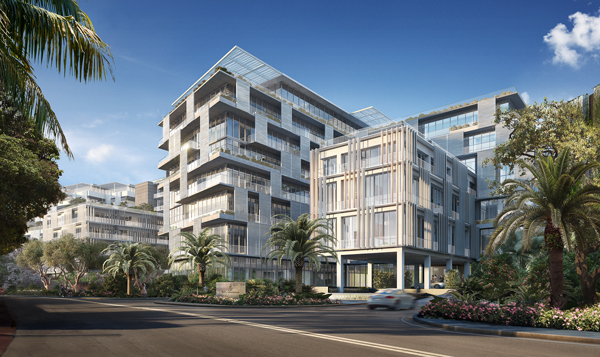Don’t ask architect and designer Piero Lissoni about design trends. The playful Italian admits he doesn’t follow them. When it comes to style, he says he creates his own. And he only works with clients he likes.
Lissoni, 60, co-founder of the Lissoni Associati group known for work from furniture to hotels, is busy in Miami with luxury residential projects including the Ritz-Carlton Residences Miami Beach, Oceana Bal Harbour and Gran Paraiso. His firm employs about 100 people, keeping offices in Milan, New York, Tokyo and Miami.
By phone from Italy, Lissoni spoke with TRD about designing for Miami, differences between European and American style and having to be “schizophrenic” to run a global firm, among other topics. The interview has been edited for clarity and space.
What makes Miami different for design? First, Miami has a special light. Second, it has a combination of many different architectural thoughts. It’s modern on Brickell Avenue, full of incredible new towers. It’s Deco on South Beach. It has modernist buildings from the ’50s and ’60s. And everything is connected by water. You have ocean with beaches, lagoons with islands, and you have canals. It’s like Venice. And now it’s become one of the most interesting towns in the world, with the opera house, new museums, new intellectual life, new business … and more Europeans and South Americans than before. It’s become so cosmopolitan.
What are the challenges in designing for Miami? The competition is very high. Miami discovered European and international architects, and the architectural quality is rising. The challenge is to be better than the others who are there. In designing the Ritz-Carlton Residences, I tried for something more connected with nature, because so much in Miami is wide with balconies or tall with terraces. I tried for something more complicated, with many different facades, different dimensions and architectural qualities — like a small Portofino village.
Some say the execution in Miami is not great. Is that your experience? It’s a challenge across America: Pressure to build faster and cheaper reduced expectations … We’re passionate about craftsmanship, and it’s an important part of what we bring to a project as an Italian firm.
You’re not here in Miami. How difficult is it to work remotely? We have a studio in Miami and people on-site. You can’t do it without people on-site.

A rendering of the Ritz-Carlton Residences Miami Beach
Miami has a lot of foreign buyers. Does that influence your design? No. When you design, it’s for a very restricted number of people. In the end, I design with my style. Otherwise, if you try to convince everyone, you always do something wrong. Lucky for me, owners and developers choose me for the way I use architectural and design language. And clients from Europe, South America and the U.S. come because of what we propose. It’s not a soup that you put everything in.
How would you describe your style? Minimalistic, simple and elegant.
What did you have in mind with the Oceana Bal Harbour project? That project was a collaboration between architects Arquitectonica, artist Jeff Koons, landscape designers Enea and us — all working together. From my side, I tried to achieve and understand the boundaries: the special view from the lobby — you see what happens seaside and on the green, you see the sculpture by Jeff Koons, you understand the light outside. It was designed like you’re in a super-, super-beautiful living room with incredible art, land and quality architecture around you.
We designed some parts inside the bathrooms, kitchens and apartments, and we designed the public spaces. We tried to give clients the special European taste for living. The entrance we designed is like a super lobby in a beautiful, five-star European hotel, with all the services inside.
How would you define the difference between European taste and American? I only know that I am Italian. What can I say? We are different, of course. We are a bit more complicated, we Europeans. We try to use a special level of connection, to mix and match different styles, times and opportunities. In our culture, it is possible to use modern with antique, with pieces from China, carpet from India, with something interesting from the flea market. It’s our level of complexity.
What other projects are you doing in the Miami area? We’re involved with Monaco Yacht Club in Indian Creek and with Gran Paraiso in Edgewater with Jorge Perez.
Where else are you working? We have projects all around the U.S. and in Mexico and South America. We’re in Cancun, Mexico City and Buenos Aires. We have projects in Europe, Japan, Russia, Emirates, Lebanon, Israel … Is that enough?
What design trends do you see in Miami? I don’t know. I never follow the trend. Normally, I am the trendsetter.
What is the craziest thing a developer ever asked you to do? Nothing, because I’m crazier than my clients.
How do you convince your clients to accept your crazy ideas? To be honest, without a good client, nothing is possible. The clients are inside the process to help and build a very good project. It’s a day-by-day discussion to transform something into an outstanding project. To get a good client, first, they choose me, and second, I choose them, because if I don’t like them, I don’t work with them.
How do you choose that good client? I look for the capacity to be interesting. I need from the client curiosity, community, a special taste … and a good relationship. Because, we spend a lot of time together and work together for many years. If you don’t have a good personal relationship, it’s impossible to do anything.
How do you manage a global operation? You need to be a bit schizophrenic. You need to have good associates and choose good clients. It’s hard work.
